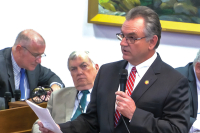Haywood commissioners, schools stick to funding formula
Haywood County Schools will see a slight budget increase from county commissioners next year, although it will fall far short of what school officials asked for.
The school system will get an extra $280,000 from the county — about a quarter of the $1.1 million increase the school system would have liked. But school officials were quick to give county commissioners an ‘A’ for effort.
“I am not going to throw them under the bus because they have been, I feel like, very fair,” said Chuck Francis, Haywood school board chairman.
Haywood County ranks high compared to other counties when it comes to school funding. It’s in the top 20 percent statewide for its per-student funding at the local level — ranking 21st out of 115 school districts.
Schools in Haywood County rank high academically as well. Haywood is 17th out of 115 school districts statewide, based on academic performance measures.
“Education is like any other enterprise. It costs money,” said Commissioner Chairman Mark Swanger.
Related Items
Haywood County’s local school funding will clock in at $1,943 per student in the coming fiscal year, up from $1,899 per student last year.
SEE ALSO: Schools grapple with three doors and a tough choice
The 2.3 percent increase for schools is the biggest increase in the county’s budget. It’s not only one of the few areas to get a budget increase, but commissioners even cut other areas of the budget to afford the school increase without raising property taxes.
Clockwork budgeting
Both commissioners and school board members chalk up the fairly amicable budget give-and-take between them to a funding formula derived over a decade ago. The formula was aimed at depoliticizing the annual fight over how much the school system would get each year.
The funding formula calls for a slight but consistent increase each year, making measured progress without putting commissioners in the middle of line-item budget requests from the schools.
“The school board makes the decision what to do with it. They have the responsibility to prioritize that money and spend it accordingly,” Swanger said.
This year’s county budget once again follows the formula.
“We made a commitment to use the funding formula, and it is important to keep your word,” Swanger said. “Especially when it comes to education.”
But the funding formula has its downsides. County commissioners have routinely fallen back on the funding formula as a crutch — sticking to the increase called for in the formula, but no more.
This year, the built-in increase under the funding formula isn’t enough to cover everything school leaders want (see related article.)
“The perspective of the county commissioners is ‘You all have been on the funding formula for a decade and we have given it to you pretty much every year. You have the freedom to do whatever you want with the allocation we give you,’” Assistant Superintendent Dr. Bill Nolte said.
The past two years, however, commissioners offered the schools a shot at getting more. If the school board could sell the idea of a property tax hike for education to the public, then commissioners would consider it.
But school board members weren’t willing to wade into the politics of taxing and spending decisions, or serve as political cover for commissioners to raise property taxes.
“That’s kind of been a point where our board has dug in our heels and said, ‘No, that is not our responsibility,’” Francis said. “We go to them and say ‘If you can do above and beyond the funding formula that’s great.’ But if you can’t, well, there you go.”
Commissioners, in turn, claimed a property tax increase was the only way they could give schools a more sizeable bump — and they expected the school board to publicly stand up for it. That could happen one day, if the school board wants to join commissioners in sticking their neck out for a tax increase for education.
“That’s when you have to say, ‘As a board we are willing to go down the path with (commissioners) to ask folks for it,’” Francis said.
But there’s a more immediate question to be answered between now and next year’s budgeting cycle.
“Do we want to continue with the funding formula, do we want to tweak it, or do we want to leave it as it is?” Francis said.
The small budget increase built into the school funding formula can quickly get sucked up by the increased cost of doing business year over year — from higher utility costs to higher health insurance costs.
The small increases from the county also haven’t been enough to offset cuts in state funding, according to Superintendent Anne Garrett’s school budget overview.
As a result, the modest increase in the formula never seems to be enough to tackle big ticket items on the wish list, be it a roll-out of laptops for students or raises for teachers.
Paved with good intentions
Commissioners announced early on in budget talks this year that they wanted to honor the funding formula. But coming up with even that money was another matter.
They had little appetite for raising property taxes. In those same early budget talks, commissioners unequivocally decided they wouldn’t do that.
Sales tax didn’t seem a very promising avenue to come up with extra money either. Counties get a small cut of the state sales tax. The more consumers spend, the more the state collects in sales tax, and the more that comes back to the county.
But projections pegging sales tax will show little if any increase in the coming year, dashing hopes that sales tax could be a go-to source of extra money.
Refusing to raise property taxes, coupled with only a small increase in sales tax, posed a conundrum for commissioners if they indeed wanted to increase school funding.
“The anticipated increase in revenues is less than what was needed to cover the funding formula for the schools. Carrying out the funding formula will take all of the surplus projected revenues plus some,” County Manager Ira Dove said in his budget assessment.
Ultimately, the county had to cut other areas of the budget and redirect it to the schools in order to honor the funding formula and give them a budget increase.
But it wasn’t easy, given outside factors making additional dents in the county’s budget. For example, the county saw a nearly $300,000 increase in the cost of benefits for employees and retirees. The county is also seeing increases in everything from medical costs for jail inmates to the added manpower needed to process social service benefits following the roll-out of a new, more labor-intensive state computerized system, known as NC FAST.
The $280,000 increase to schools isn’t the only new money in the county budget, however, even though it’s the biggest increase for any single department.
The county is giving a one-time grant of $700,000 to Evergreen paper mill in Canton to help the mill afford a costly conversion from coal to natural gas to meet air pollution standards, heralded as a move to help protect mill jobs. And the county has built enough extra money into the budget — roughly $360,248 — to give 2 percent merit raises to every employee.
But the budget is not flush with such examples.
“This budget reflects the competing themes of prudence and hope, yet lands squarely on the side of prudence,” Dove summed up during a county budget overview last week.
By the numbers
While the majority of school funding comes from the state, county funding plays a critical role in school operations.
Haywood County will pitch in $14.645 million this coming year. That’s nearly 30 percent of the school systems’ operating budget.
What does it go toward? Here’s just a small taste:
• 54 teachers, above and beyond the teaching positions paid for by the state
• 7 teachers assistants, to ensure every kindergarten and first-grade classroom has an assistant.
• $251,000 for substitutes.
• school resource officers for middle and high schools.
• 10 IT positions for computer support for schools.
• $1.9 million in utilities.
• $279,000 for athletic coach salaries.
• $1.08 million for routine maintenance.









